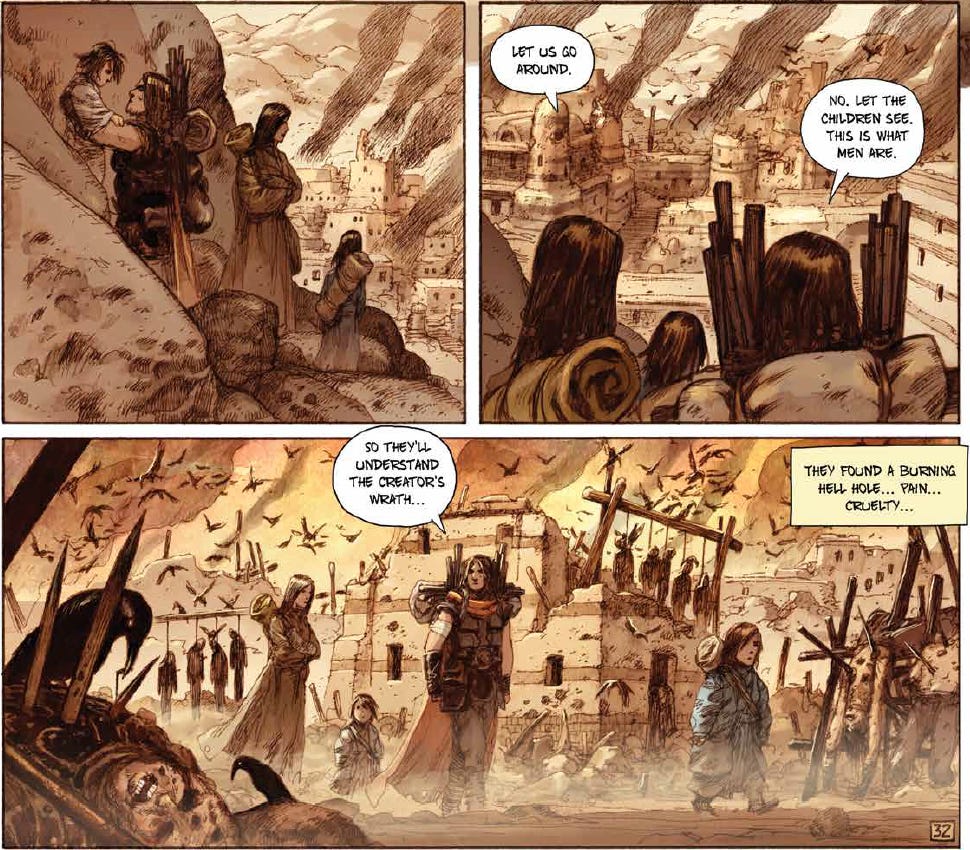Darren Aronofsky's Noah – Chapter 4
The polluted landscape, the significance of Ila's name, and the very different origins of the Watchers Og, Samyaza, Rameel, and Magog.
Intro | 1 | 2 | 3 | 4 | 5 | 6 | 7 | 8 | 9 | 10 | 11 | 12 | 13 | 14 | 15 | 16 | 17 | 18 | 19 | 20 | 21 | 22
Haunted by the vision that God sent him in a dream, Noah takes his family on a journey to see his grandfather Methuselah.
Along the way they encounter a series of polluted landscapes (the clearest expression of the film’s environmentalist subtext) as well as evidence of man’s inhumanity to man. They also meet a number of characters who will prove quite providential: one human, the others... not.
NAAMEH: It’s a long and dangerous journey for the boys. How do you know your grandfather’s still alive?
NOAH: I don’t. I saw his mountain. We need to go and find out if he knows what we’re to do.
HAM: Shem, can you help me with this?
NAAMEH: We could take the boys and find a place to hide.
NOAH: There’ll be no hiding. We should have left already.
Themes. Here we see an early indication of the difference between Naameh’s protective instincts, especially where her children are concerned, and Noah’s determination to follow the course of action that he believes God has laid out for him and his family.
NOAH: Ham, let me show you how to do that. Push it in here. Next time we come through, we’ll know we’ve got certain things we might need.
Development. According to the published screenplay, Shem and Ham “are burying items they cannot carry with them.”
NAAMEH: There are cities ahead.
NOAH: We will not get too close.
Development. In the early screenplay and graphic novel, Naameh suggests going around a burning, corpse-strewn village, and Noah says they should walk through it instead, so that their children can see what humanity has become and why the Creator is angry with us.
In August 2014, after visiting the Athabasca oil sands in Alberta (also known as the Alberta tar sands), Aronofsky told the Earth Island Journal that he researched “the worst polluted places on the planet” while developing the film, and he said the tar sands in particular were “a big influence on the visual look of the prediluvian world.”
Music. The music that plays over the bulk of Chapter 4 is called ‘A Sweet Savour.’ The title comes from Genesis 8:21, and describes how God accepts the burnt offerings made by Noah after the Flood is over. The use of that title in this context—where the landscape is polluted and strewn with dead bodies, animal and human alike—is, needless to say, ironic.
SHEM: Is that a tzohar mine?
NOAH: It was once. Before they dug it all up.
NAAMEH: Should we go around?
NOAH: No.
Development. If the set design looks industrial, but not necessarily like what you’d expect from a land-based mining operation, that may be because the filmmakers filled the landscape with pieces of large boats. In the Blu-Ray featurette ‘Iceland: Extreme Beauty,’ production designer Mark Friedberg gestures around the set and says “almost everything in here is nautical.”
Keep reading with a 7-day free trial
Subscribe to Thoughts and Spoilers to keep reading this post and get 7 days of free access to the full post archives.




